|
The Model 1892 Winchester is one of the
great rifles of all time. It was designed at the request of
Winchester Repeating Arms Company by John Browning as a
scaled down version of the Model 1886 rifle. The Model 1886 was
ideal to handle the large rifle cartridges of the day, but
Winchester wanted a handier, lighter, and stronger replacement
for their Model 1873 rifle, which handled the shorter cartridges
that were popular with shooters, hunters, and frontiersmen. The
story goes that T.G. Bennett, Oliver Winchester’s
son-in-law, offered Browning a ten thousand dollar bonus if he
could deliver the design in ninety days, or fifteen thousand if
delivered in sixty days. Browning countered with an offer
to deliver the rifle in half that time if Bennett would double
the offer. Bennett agreed, and to his surprise, Browning
delivered. Bennett paid the twenty grand, which was a lot of
money in the late nineteenth century, and began manufacture on
one of Winchester’s best selling rifles.
The rifle that Browning delivered is what was
introduced as the Model 1892, commonly called the Model 92
today. It is a superb levergun, efficiently handling cartridges
such as the .32, .38, and .44 WCF cartridges originally, and
today the 92 is manufactured by others and chambered for the .38
Special, .357 magnum, .44 magnum, .45 Colt, .454 Casull, and the
.480 Ruger cartridges, in addition to the originals. Versions
have also been chambered for the .218 Bee, and probably a few
others that I have forgotten.
When introduced, the Model 1892 was welcomed in
large numbers, with over a million produced over the following
five decades. It was a strong, handy, and very reliable lever
action rifle, and was made as short-barreled carbines, full
length rifles, short rifles, and even as full-stocked military
muskets.
Today, it is left to foreign manufacturers to
build the Model 92. Rossi in Brazil has been producing
the rifles for many years, along with Armi San Marco in
Italy for a while also. Now, Armi Sport of Italy is also
producing the Model 92 rifles and carbines, and Cimarron
Firearms in Fredericksburg, Texas is bringing in Armi
Sport rifles built to their high standards. There were
some reliability problems with a few of the early guns, and
Cimarron rejected them until the hiccups could be corrected.
They wanted the guns to be right before placing them on the
market. That puts me about a year later than I had hoped to be
able to get a production gun for review, but it has finally
arrived, and was definitely worth the wait.
My first impression was that this is one
beautiful levergun! The fit and finish are very good, the
quality of the walnut is exceptional, and the colors of the case
hardened receiver are gorgeous. Then, I cycled the action. I had
handled a few Cimarron 92s at SHOT
in Orlando that were equally as slick, but show guns usually
are. However, this Model 92 is without a doubt the
slickest-working action that I have ever handled on a levergun,
and I have handled plenty, including several old Winchesters.
I immediately called Cimarron, thinking that they had
cherry-picked a rifle for me, but the lady that ships these out
swears that she just pulled a box off the shelf. This
Model 92 will certainly run, and is smoother than most Model
1873 rifles, a design that is widely held to be much smoother
than a 92...and they usually are. We included a video in this
review that just shows the Cimarron cycling a load that many
leverguns choke on, that being a .45 Colt case loaded with a .45
ACP 200 grain target wadcutter bullet. Most leverguns prefer a
round-nosed bullet for reliable feeding, but the Cimarron did
not care. If the cartridge overall length was within specs, the
Cimarron would smoothly feed it.
As they should, the Cimarron rifles have the
curved steel rifle buttplate and rifle-type forend cap, which
are both case hardened to match the receiver, lever, hammer, and
trigger. The action uses the original type leaf spring, which no
doubt contributes to its smoothness of operation. There are no
ridiculous safety levers added as afterthoughts to the Cimarron
as can be found on some other Model 92 rifles. The action works
perfectly well, and is perfectly safe to operate just as
designed by John Browning well over one hundred years ago. The
hammer has the proven and traditional half-cock safety notch,
and it serves very well. The front sight on the 1892 is a blade
that is set in a dovetail base, allowing for windage correction
by loosening a small screw and drifting the base opposite the
direction that the shooter wishes to move the bullet impact. The
rear sight is elevation adjustable with the sliding ladder, and
windage adjustable by loosening a small screw and drifting the
sight in the direction in which the shooter wishes to move the
bullet impact.
Loading the 1892 Cimarron was simple and easy,
sliding up to thirteen .45 Colt cartridges into the loading gate
located on the right side of the receiver. Chambering a
cartridge and topping off the magazine gives the shooter
fourteen powerful .45 Colt cartridges at his disposal before
reloading. One of the great advantages of most leverguns is that
the magazine can be topped off at any time during a lull in the
action. There is no need to take the rifle out of the fight to
reload. Many shooters overlook the levergun as a fighting rifle,
but it served well in that role for decades. A good, reliable
lever action rifle or carbine is an excellent fighting weapon.
As a hunting rifle, the 1892 is limited only by the shooter’s
ability to accurately place his shots using the open sights. For
such work, the Cimarron is drilled for a tang sight to be easily
added if desired, and for most of us, that addition makes the
rifle easier to shoot accurately. As is, I would not
hesitate to take the .45 Colt Cimarron after whitetail deer out
to one hundred yards, and a hunter with better eyes could
stretch that distance a bit farther. Any longer range than that,
I will happily plink away at rocks and other inanimate targets,
but won’t shoot at game with a rifle sighted this way. Nothing
at all wrong with the sights, it is just my limited ability to
use them well. At longer range, I need a peep sight of some
type, whether tang or receiver mounted.
The trigger pull measured an average of just
under three pounds on my Lyman gauge. The excellent trigger pull
on the Cimarron contributed to its ease of shooting well at
targets, and at twenty-five yards paper targets, the rifle would
put my handloads into the same ragged hole, as long as I did my
part. Using a Merit attachment
to my shooting glasses, I did just that a few times. For use on
game such as deer and hogs, Buffalo Bore makes an
excellent load that uses a 300 grain jacketed flatpoint bullet,
and the load is not Plus P rated, meaning that it is suitable
for any good .45 Colt chambered rifle or handgun that is in good
mechanical condition, and made for smokeless loads. The Cimarron
is certainly plenty strong enough to handle the ammunition.
Buffalo Bore rates this load at 1200 feet-per-second (fps) from
a handgun, and it clocked 1523 fps out of the Cimarron 1892
rifle’s twenty-four inch barrel. Weighing in at six and
three-quarters pounds, the Cimarron is light and handy enough to
carry well, but has enough heft that the 300 grain Buffalo Bore
standard pressure loads were very comfortable to shoot. This is
an excellent load for the rifle, and it will penetrate any
whitetail made from either side, and most of them lengthwise.
The load shot right at the top of the sights at twenty-five
yards with the ladder in its lowest position, and was just a bit
low at one hundred. For hunting, this load would
definitely be my choice. I tried several other factory loads
through the Cimarron, and again, if they were not excessively
long, they cycled just fine.
For carrying afield, nothing carries like a
‘92. That wonderfully round receiver bottom is ideal to
comfortably tote the rifle all day long. Even with the
twenty-four inch barrel, the Cimarron carries very well for me.
The octagon barrel on the 1892 adds a little to
the forward balance, and the rifle hangs very well on target,
without seeming unbalanced. It has just the right feel to it;
not light and whippy, but balanced with just a bit of forward
heft to make it feel like a real rifle, which it certainly is.
Cimarron offers this rifle chambered for your
choice of the .38 Special/.357 magnum, .44 WCF (.44-40), .44
magnum, or the .45 Colt cartridge, in either solid frame or
takedown models.
I really like this Cimarron rifle very much. If
I decide to buy it, I will most likely add a Firesight
to the front and an XS Sights ghost ring receiver
aperture at the rear, to better suit my aging eyes. The
rifle ain’t cheap, as quality never is, but with Cimarron, you
get your money’s worth. This would be a superb rifle for Cowboy
Action Shooting just as is, with no need to have the
action slicked up, as it is very slick already. It is a
quality-built 1892, and I think that John Browning would
approve.
For more information on this and other Cimarron
firearms, go online to: www.cimarron-firearms.com.
To order Buffalo Bore high performance premium
hunting and fighting ammunition, go to: www.buffalobore.com.
If all of Cimarron’s Model 92 rifles are as
good as this one, they definitely have a real winner, both in
competition, and in the hands of hunters and shooters. I
highly recommend it.
Jeff Quinn
  
Got something to say about this article? Want to agree (or
disagree) with it? Click the following link to go to the GUNBlast Feedback Page.
|
|
Click pictures for a larger version.
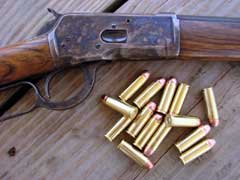
Cimarron .45 Colt Model 1892 Lever Action Rifle.
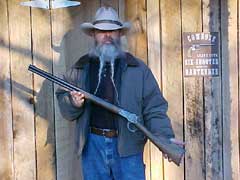
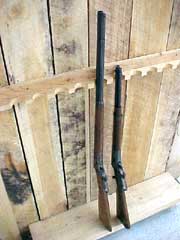
Size comparison: Cimarron 1892 (left), 16-inch Puma
Model 92 (right).
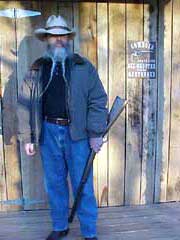
Even with the longer barrel, the Cimarron 1892 carries
easily.
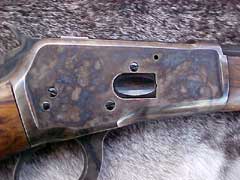
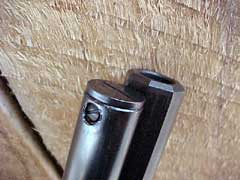
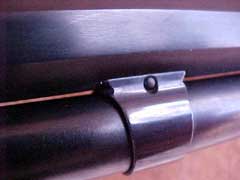
Full-length magazine attaches to barrel in two places.
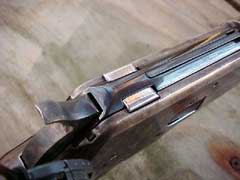
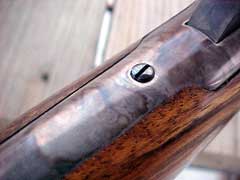
A nice touch: the rifle is already drilled for a tang
sight.
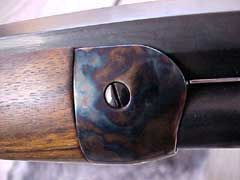
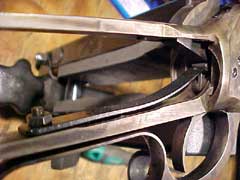
Action uses a traditional leaf hammer spring.
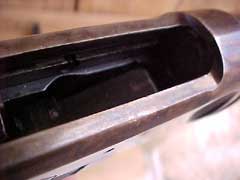
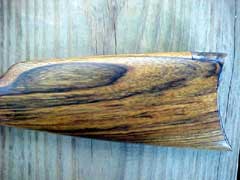
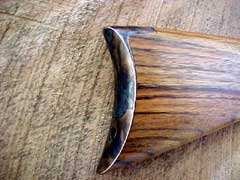
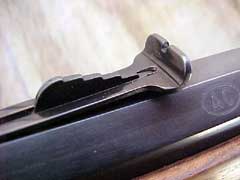
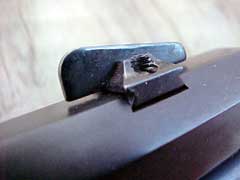
Sights consist of traditionally styled sliding ladder
style rear (top), and dovetailed blade front (bottom).
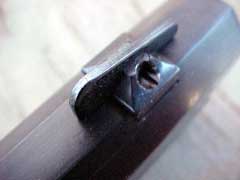
Front sight blade is adjustable for windage by loosening
a set screw.
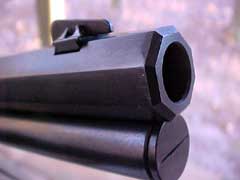
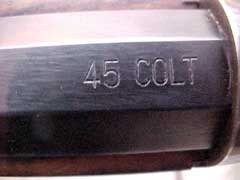
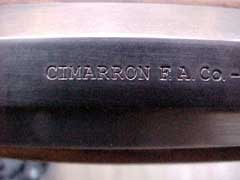
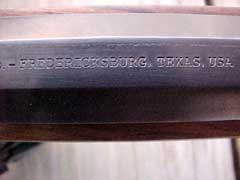
Barrel markings are aesthetically pleasing to the
levergun purist...
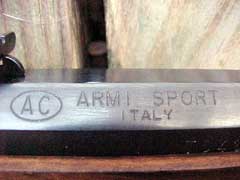
...Well, most of 'em, anyway!
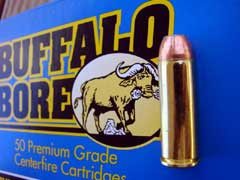
Buffalo Bore's 300-grain JHP load is a fine choice for
field use.
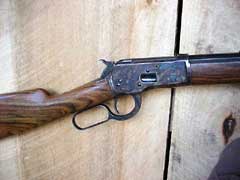
Jeff loves Model 1892 rifles, and this Cimarron is one
of the finest examples available.
|
![]()